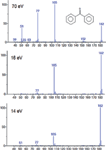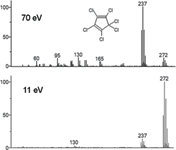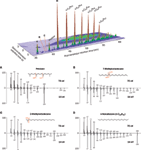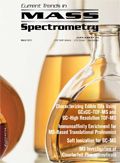A New Outlook on Soft Ionization for GC–MS
Special Issues
Despite the advantages of soft ionization ion-source technologies for improving confidence in the identification of a range of challenging analytes, soft ionization remains a niche technique for gas chromatography–mass spectrometry (GC–MS).
Despite the advantages of soft ionization ion-source technologies for improving confidence in the identification of a range of challenging analytes, soft ionization remains a niche technique for gas chromatography–mass spectrometry (GC–MS). This article discusses the reasons for this limitation as well as new developments that make lower-energy electron ionization possible without the disadvantages that have historically been associated with it. The specific benefits of this technique are discussed by reference to several examples across the GC–MS field.
The term "soft ionization" encapsulates a range of techniques that ultimately result in analyte molecules that become ionized without imparting excess energy to them. The result is a limited degree of analyte fragmentation, meaning that the molecular ion passes intact through the mass spectrometer and to the detector. This ability to provide information about the unfragmented molecule makes soft ionization of great value to analysts.
For macromolecules, the ready fragmentation of the molecular ion means that soft ionization is the only suitable technique and, in this field, matrix-assisted laser desorption–ionization (MALDI) is a popular method for ionizing DNA, proteins, peptides, sugars, polymers, and dendrimers.
However, for smaller analytes amenable to gas chromatography (GC), high-energy electron ionization (EI), typically at 70 eV, is by far the most popular technique. Large libraries of spectra such as those curated by the National Institute of Standards and Technology (NIST) and Wiley are available for matching and identification, and have long been used by analysts across a wide range of gas chromatography–mass spectrometry (GC–MS) applications. In this field, methods for soft ionization have historically been viewed as more specialized, and more often used in cases where EI at 70 eV does not provide adequate results.
There are multiple reasons for this. The major factor is that EI, which although by its nature is applicable to almost every vaporized substance, cannot be used successfully at lower energies. This is because of inefficient channeling of electrons from the filament ("e-gun") into the ion chamber, giving an extremely low signal and an unacceptable loss of sensitivity.
Therefore, to achieve soft ionization, analysts have turned to other techniques, of which chemical ionization (CI) is the most common. CI also results in a drop in sensitivity, but to a far lesser extent than EI. Unfortunately, however, CI requires a different ion-source configuration, with additional source pressurization and the use of reagent gases. If a single instrument is being used, this can be a time-consuming transition and a considerable drain on laboratory resources if required on a regular basis.
The challenge, therefore, remained of developing a convenient soft ionization technique that retained the performance and wide applicability of standard 70-eV electron ionization. Hence, we were excited by the development of an e-gun design that removes the link between the energy of the electrons and the ionization efficiency, by introducing an additional electrostatic element between the e-gun and the ion chamber. This allows the ionization energy of the electrons to be varied on a sliding scale from conventional 70 eV to lower energies, without loss of sensitivity.
The Advantages of Variable-Energy Electron Ionization
A key feature of this variable-energy electron ionization is the avoidance of sensitivity losses; absolute ion intensities at low energies have been found to be equal to or greater than at 70 eV. On its own, this would not be particularly useful, but in conjunction with the improved signal-to-noise ratios at low energies (see below), the result is lower detection limits for target compounds. Furthermore, greater sensitivity allows analysts to use the same sample loading and analytical conditions for both hard and soft ionization, meaning less time is spent on sample preparation and method development.
Like other soft ionization techniques, using EI at low energies inherently results in reduced fragmentation, and (as a consequence) an enhanced molecular ion. Importantly, however, we have found that a degree of fragmentation is usually retained even at the lowest energies. The ions produced are typically those that arise from the lower-energy fragmentation pathways, that is, larger ions that are more significant in terms of understanding the structure of the molecule. These larger ions are more often those required for quantitation, and so their increased intensities also benefit calibration.
In addition to reduced fragmentation of the analyte, fragmentation of chromatographic background and carrier gases is also reduced. This greatly improves the signal-to-noise ratios for analytes, reduces demand on the dynamic range, and improves limits of detection, particularly in complex or more "dirty" samples.
Another important point to note is that switching from regular 70-eV ionization to lower energies is inherent to the design, and can be carried out by changing a method parameter in the MS software. As well as avoiding the inconvenience of changing from EI to an alternative soft ionization technique, this allows sequences of samples to be repeated automatically at different energies, with subsequent savings of time.
The inherent variability of the technique is also helpful, by allowing the analyst to adjust the ionization energy to suit the situation, and discover optimal parameters during method development. Relatively small differences in ionization energies at the low end of the scale can have significant differences. For example, note the difference in relative intensity of the m/z 105 and 182 signals at 16 eV and 14 eV for benzophenone (Figure 1).

Figure 1: Comparison of mass spectra for benzophenone at 70, 16, and 14 eV.
The variable-energy ionization technology described above was developed by modifying the ion source for a time-of-flight (TOF) mass spectrometer (BenchTOF, Markes International), which is able to produce reliable 70 eV spectra that are a close match to those in standard libraries. The following three examples illustrate the use of the new system.
Example 1: Confirming Compound Identity
Even when using a TOF-MS that produces spectra free from mass discrimination, uncertainties can arise when compounds have weak molecular ions or extensive fragmentation at regular 70-eV ionization energy. As illustrated in Figure 2 for the common pesticide precursor hexachlorocyclopentadiene, reducing the ionization energy can greatly enhance the molecular ion, thereby providing an additional degree of confidence in identification.

Figure 2: Comparison of 70-eV and 11-eV EI spectra for hexachloro-cyclopentadiene, showing the greatly enhanced molecular ion at the lower energy.
Example 2: Differentiating Between Isomeric Compounds
The ability to provide enhanced molecular ions while retaining structurally significant fragment ions improves discrimination between compounds that have similar spectra at 70 eV. Figure 3 shows an example of this increased orthogonality for four hydrocarbons in a crude oil.

Figure 3: Top: GCÃGCâTOF-MS contour plot of a crude oil, showing overlaid EICs (m/z 268 + 282 + 296 + 310 + 324 + 338 + 352), analyzed with an ionization energy of 14 eV. The panels below (aâd) show the 70-eV and 14-eV EI spectra for each of the four labeled peaks AâD, respectively, illustrating that it is much easier to discriminate between these compounds using the low-energy spectra.
Example 3: Enhancing Signal-to-Noise Ratios
At low ionization energies, the reduction in the degree of fragmentation of both analytes and chromatographic artifacts helps improve signal-to-noise ratios, with subsequent lowering of the limits of detection. This is illustrated in Figure 4 for the odorous compounds safrole and coumarin, in which the increase in molecular ion intensity and reduction in fragmentation on moving from 70 eV to 15 eV result in an approximately twofold increase in the signal-to-noise values for the molecular ions.

Figure 4: Comparison of 70-eV and 15-eV EI spectra for the allergens safrole and coumarin, showing the enhanced signal-to-noise ratios at the lower energy.
Conclusion
The variable-energy ionization approach described in this article is a rugged technique that has the potential to deliver significant benefits to GC–MS laboratories across a wide range of applications.
The ability to easily switch between hard and soft EI allows both regular 70-eV spectra to be generated for matching against existing libraries, alongside lower-energy spectra that provide complementary information on the molecular ion and structurally significant fragment ions. This complementary information enables more confident identification and discrimination between isomers that previously would not have been resolved.
Furthermore, the reduced fragmentation of analytes, matrix interferences, and carrier gases significantly improve signal-to-noise ratios for target substances, and allow lower limits of detection to be achieved.
For more information about variable-energy electron ionization, and detailed experimental information on the examples covered in this article, please contact the authors.
Laura McGregor, Nick Bukowski, and David Barden are with Markes International, at the Gwaun Elai Medi-Science Campus in Llantrisant, UK. Direct correspondence to: enquiries@markes.com

High-Speed Laser MS for Precise, Prep-Free Environmental Particle Tracking
April 21st 2025Scientists at Oak Ridge National Laboratory have demonstrated that a fast, laser-based mass spectrometry method—LA-ICP-TOF-MS—can accurately detect and identify airborne environmental particles, including toxic metal particles like ruthenium, without the need for complex sample preparation. The work offers a breakthrough in rapid, high-resolution analysis of environmental pollutants.
The Fundamental Role of Advanced Hyphenated Techniques in Lithium-Ion Battery Research
December 4th 2024Spectroscopy spoke with Uwe Karst, a full professor at the University of Münster in the Institute of Inorganic and Analytical Chemistry, to discuss his research on hyphenated analytical techniques in battery research.
Mass Spectrometry for Forensic Analysis: An Interview with Glen Jackson
November 27th 2024As part of “The Future of Forensic Analysis” content series, Spectroscopy sat down with Glen P. Jackson of West Virginia University to talk about the historical development of mass spectrometry in forensic analysis.
Revealing the Ancient Secrets of Chinese Swamp Cypress Using Cutting-Edge Pyrolysis Technology
November 18th 2024A study published in the Journal of Analytical and Applied Pyrolysis by Yuanwen Kuang and colleagues used advanced pyrolysis techniques to reveal the preservation and chemical transformations of 2,000-year-old Chinese swamp cypress wood, offering valuable insights for archaeological conservation and environmental reconstructions.
Detecting Cancer Biomarkers in Canines: An Interview with Landulfo Silveira Jr.
November 5th 2024Spectroscopy sat down with Landulfo Silveira Jr. of Universidade Anhembi Morumbi-UAM and Center for Innovation, Technology and Education-CITÉ (São Paulo, Brazil) to talk about his team’s latest research using Raman spectroscopy to detect biomarkers of cancer in canine sera.